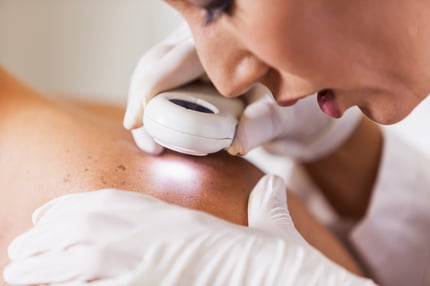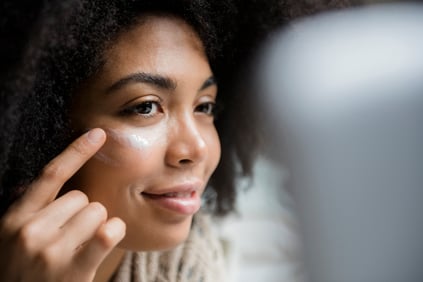How to Practice Sun Safety After Melanoma
5 min read

Author: Patrick Eulitt, MD
Melanoma is a commonly diagnosed type of skin cancer, with cases rising steadily in the last 30 years. It’s more important than ever to practice sun safety after your melanoma treatment.
The word melanoma typically refers to cutaneous melanoma, a common type of melanoma that forms in the skin’s cells that produce pigment. Prolonged exposure to ultraviolet (UV) radiation from artificial or natural sunlight is one of the leading causes of melanoma.
When doctors detect melanoma early, survival rates are high. Overexposure can happen during any season – summer, winter, or any month in between. UV exposure raises skin cancer risk, but sun safety practices can protect you.
Stages of Melanoma
Before we jump into sun safety tips, here’s a quick refresher on the stages of melanoma. Each stage has differing levels of severity and treatment.
 Stage 0. The melanoma tumor is in the upper layer of the skin, or epidermis. Cancer cells have not spread to other layers of skin or lymph nodes.
Stage 0. The melanoma tumor is in the upper layer of the skin, or epidermis. Cancer cells have not spread to other layers of skin or lymph nodes.- Stage I. The melanoma tumor is still local to the epidermis and the dermis, the layer of skin below the epidermis. Cancer cells have not reached the lymph nodes.
- Stage II. The melanoma tumor is in the epidermis and the dermis. The tumor is thicker than Stage I but hasn’t spread to the lymph nodes.
- Stage III. The melanoma tumor is in lower levels of the epidermis and dermis and has spread to one or more lymph nodes.
- Stage IV – The melanoma tumor is located below the dermis and has spread to the lymph nodes and other areas of the body.
Melanoma grows quickly and can reach advanced stages in as little as six weeks.
“It’s important for patients to speak with a dermatologist or oncologist as soon as you notice any abnormal skin growth,” said Dr. Patrick Eulitt, medical oncologist at Rocky Mountain Cancer Centers (RMCC). “The sooner melanoma is discovered, the more effective treatment is.”
Does Melanoma Come Back?
After it has been treated, it’s possible for melanoma to come back. This is called recurrence, and your doctor can discuss your individual risk of recurrence. Most instances of melanoma recur within two to three years of diagnosis but can reoccur within 10 years. After a decade, recurrence is unlikely but not impossible.
Most often, melanomas recur in the same location as the original diagnosis. Yet, if cancer cells are left behind after treatment, it’s always possible to have a recurrence in other places on your body. The risk of recurrence is one of the primary reasons why sun safety after melanoma is so important.
Recurrence is not the same as a second, new melanoma due to the same risk factors that led to the first melanoma diagnosis.
Be Prepared to Stay Safe in the Sun
After a melanoma diagnosis, you can still enjoy the great outdoors and practice sun safety at the same time. Remember to follow sun safety practices all year round by following these sun safety tips:
 Begin with sunscreen. There are many types of sunscreens. Finding the right one for you may take some experimenting. No matter the formula, choosing a broad-spectrum sunscreen that protects against UVA and UVB rays with a sun protection factor (SPF) of 30 or higher is important. Water-resistant sunscreen can prevent removal as you sweat or go swimming. Use make-up products with SPF and put on an SPF sunscreen underneath.
Begin with sunscreen. There are many types of sunscreens. Finding the right one for you may take some experimenting. No matter the formula, choosing a broad-spectrum sunscreen that protects against UVA and UVB rays with a sun protection factor (SPF) of 30 or higher is important. Water-resistant sunscreen can prevent removal as you sweat or go swimming. Use make-up products with SPF and put on an SPF sunscreen underneath. - Don’t forget the hats and sunglasses. It may seem simple, but hats and sunglasses offer great UV protection for your skin and eyes. Avoid hats made from mesh or straw. A tight weave will allow less sunlight to penetrate the fabric. The wider the hat brim, the greater the protection for your neck and ears. Sunglasses that block UVA and UVB rays will help keep your eyes safe. If you wear a baseball cap, be sure to use sunscreen on your ears and the back of your neck.
- Find some shade. Staying in the shade during the peak of the day can help protect you from the sun’s strongest UV rays. Find a shady spot between the hours of 10 a.m. and 4 p.m. Be sure to wear your sunscreen and protective clothing, because shade only offers partial protection from UV rays.
- Stay away from windows. Windows offer almost no sun protection, although some car windshields may protect against UVA rays. If you’re a frequent traveler or you drive long distances during the sun’s peak, wear sunscreen and clothing with sun protection even inside the car.
- Use clothing with sun protection. Wearing long sleeves and pants offer some protection against sun exposure. According to the Centers for Disease Control, dry clothes are more protective than wet clothes, and dark colors may offer more protection than lighter colors. For even greater protection, look for clothing that contains ultraviolet protection factor, also known as UPF. Clothing with UPF has sun protection woven into the fabric. UPF has a rating listed on the clothing item’s label. Regular and UPF clothing doesn’t offer complete protection. Combine it with sunscreen to block more UV rays.
Skin Self-Exams: A Vital Sun Safety Tip
If you’ve been practicing good sun safety after melanoma, you have an added layer of protection against recurrence. A skin self-exam, however, is the most powerful sun safety tool in your toolbox.
“Even if you’re staying consistent with sun safety, self-exams are a great way to stay on top of your health,” Dr. Eulitt said. “At RMCC, our commitment to long-term follow-up care involves supporting patients who are interested in conducting effective self-exams at home.”
Make skin self-exams easy by remembering the “ABCDE” rule when examining moles or skin growths:
- Asymmetry, when the shape of one side doesn’t match the other.
- Borders that are irregular with blurry, ragged, or notched outlines. Sometimes the color of the mole will seem to spread into the skin surrounding it.
- Color that’s uneven with different shades of black, brown, or tan. You may see white, blue, red, and other colors as well.
- Diameter that grows over time. Melanomas tend to be about a quarter of an inch wide or bigger.
- Evolving, when a mole changes over weeks or months
After a melanoma diagnosis, it’s normal to worry about recurrence. Keep in mind however, that practicing good sun safety after melanoma and keeping up with regular skin self-exams gives you more control over your risk of recurrence.
“Recent treatment advances have allowed patients with melanoma to live longer with fewer side effects,” Dr. Eulitt said. “As treatments continue improving, lifestyle changes such as sun safety and physician-guided skin exams will continue to improve outcomes.”
Rocky Mountain Cancer Centers can help you stay safe in the sun following melanoma treatment. Get survivorship resources at www.RockyMountainCancerCenters.com/Cancer-Survivorship.